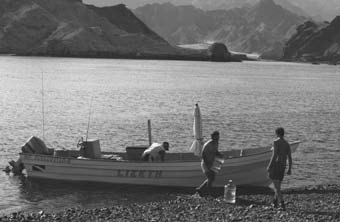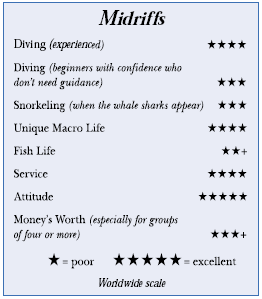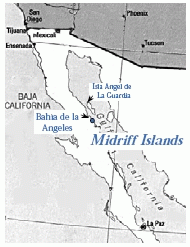Midriff Islands, Sea of Cortez, MexicoContents of this Issue: Midriff Islands, Sea of Cortez, Mexico Nimrod Explorer, Coral Sea, Australia The Right Seats for the Long Haul Do You Have the Right Dive Insurance? Surviving Three Days in 68ºF Water Does Dehydration Increase the Risk for DCS? Divers, the Internet and the Industry: Part II Editorial Office: Ben Davison Publisher and Editor Undercurrent 3020 Bridgeway, Suite 102 Sausalito, CA 94965 cool water, abundant marine life from the June, 2006 issue of Undercurrent
Dear Reader, A flicker of movement interrupted my fascination with an unfamiliar sea slug, sequestered in a miniature forest of delicately sculpted sea squirts and scarlet sponges. Like a creature from a B-horror movie, the interloper emerged from the dense growth, its dime-sized body shrouded in hairy-green algae. Then, a cast of decorator crabs rose from their hideaway sporting veils of sponges, feathery hydroids, and other hitchhikers. Here, in Julia’s Enchanted Garden, truck-sized boulders were plastered with extended tentacles and appendages scouring for food. With my light I led the swarms of plankton Pied Piper-like, into the arms of voracious sand anemones. While I spotted almost as many different nudibranchs as I had in Indonesia, a green turtle the size of a car hood and a burly free-swimming moray reminded me where I was . . . in the Sea of Cortez (the Gulf of California on most maps) in the Midriff Islands with Ricardo’s Diving Tours.
The Midriffs include more than 55 islands, islets, and pinnacles that rise from 3000-ft depths and span 80 miles in the northcentral gulf. Tidal currents race through, drawing up cold, nutrient-rich water, which mixes with warmer waters that flow north in summer. Here one finds a unique blend of species, including eastern Pacific tropicals and California cold-water marine life. Add the high concentration of whales, dolphins, and sea lions, as well as seasonal whale shark visits, and things can get interesting. Ricardo is based in the small fishing village of Bahia de los Angeles, not easy to get to because there is no commercial airport -– it’s an eight-hour drive from San Diego. He has 15 years’ experience diving and navigating the Midriffs. His is a small-town, small-boat operation, rough around the edges, but he and his son-in-law, Baruni (who provides English translation for Ricardo’s limited English), are enthusiastic with an aim-to-please attitude. One of Ricardo’s best assets are his eyes. Once it took him all of five minutes to fulfill my request for an ocellated frogfish. The plate-sized specimen was so well-concealed, it took me a minute to realize what is was. Visibility can be limited (30-40 feet in the summer and fall, but up to 100 in the winter), so sites are often difficult to find, even when fixed by GPS.
Ricardo’s operates from the town boat ramp and he’ll pick you up on shore if you’re staying along the rocky beach. While closer sites can offer good diving, serious divers will want to take the hour-plus trip to the outer islands of Isla Angel de la Guardia, Isla Partida, and La Raza, where there is better sea life, but potentially more current, especially upwellings. Though the ride can get harsh in big seas, especially on a 90-minute return trip, his boat is designed for the Gulf of California, where the sea can go from glass to a 5-foot wind chop in the blink of an eye. More than once, Ricardo’s seamanship helped us avoid potentially dangerous seas. With the help of glassy seas, we arrived at Isla Angel de la Guardia in under an hour. We anchored on the 50-ft. tall Rapture rock, where the current formed tiny whirlpools. The cacophony of 50 California sea lions told me this was their turf. I back rolled and dropped quickly to the lee of a boulder at 30 feet, where colder 70-degree water rose from the depths, clearing the visibility to 75 feet. I descended over a series of ledges to the precipice, aided by a mild down current, then plunged over the edge, eventually to 120 ft. Forests of yellow-polyp black coral swayed like horizontal weeping willows. Spanish shawl nudibranchs grazed on hydroids, replenishing their harpoon-like stinging cells. I spotted four black sea bass the size of small refrigerators. Rapture Rock rivals walls like Cozumel’s Maracaibo Deep. As I ascended, a mature green sea turtle darted into deeper water. With the current swirling around the rocks, I held on at 45 feet and watched a procession of finescale triggerfish, yellowtail snapper, and swirling masses of Mexican barracuda. Higher, barrel-chested male sea lions darted so close with bared teeth I could almost tell what they had last eaten. When I surfaced the boat was right there, as always, and Ricardo and Baruni hoisted my gear out of the water, and helped me up the portable ladder. Though only certified as an open-water diver, Ricardo has logged thousands of dives. He impressed me with his skills, though he is still learning the tricks of being a top-notch dive guide (e.g., giving a complete briefing). You can follow him for all or part of the dive or follow your own profile -- you tell him. Novices may find the conditions unnerving at times. Closer-to-town sites like Punta Pescador (max depth 40 ft.) will be more to their liking.
I stayed north of town, at Campo Archelon (resendizshidalgo@yahoo.com),which attracts an eclectic mix, including visiting scientists, assorted Baja legends, and nonlegends like me. They offer beachfront palapas ($10 per night for two) and stone cabanas with cots, stove, hot shower, and refrigerator ($40 per night for four). It’s glorified camping with a cot on a sand floor, next to the water. Glorious, as long as no wind-sounds of the sea, whale breaths, or sea lion barks. I love the tranquil setting, especially the blood-red sunrises over the bay and the tide pool that hosts more macro-life than many dives. The water is a cool refuge from the 100-degree-plus days, with nights in the 90s. In March I returned to winter westerlies roaring down the canyon, making for bumpy boat rides. While days were sunny and 75-degrees, the nights dropped into the low 50s and upper 40s. But Ricardo had a 150-hp Yamaha outboard for even faster trips and a sonar unit to locate new sites that were generally comparable or better than dives I’ve done in La Paz. Amarillo (Yellow Forest) was an exciting drift dive reminiscent of Cozumel’s Santa Rosa Wall. It was plastered in thick stands of yellow polyp black coral, which sheltered juvenile whitetip and horn sharks. Baruni’s Canyons had gorgonian-covered pinnacles dramatically rising from 200 feet and monster black sea bass in the depths. The cold water (70ºF and below) prevented longer dives; even with my new 7-mil and a hood, 45 minutes and two dives a day was it for me. Most of the tropical fish had packed their bags and headed south until the water begins to warm in late May. Between dives, six fin whales gulped plankton within a stone’s throw. At times, the air and water were so still that I could hear whale breaths miles away. Rarely a day went by without a performance by hundreds of acrobatic dolphin pods. We snorkeled with sea lions at several sites. The islands, part of the Islas del Golfo de California Protected Area, are unique, harboring blue-footed boobies and osprey, and is a temporary home for elegant terns from South America. Diving the Midriffs is a step back in time. Pristine water, no other divers, and some of Baja’s best diving at sites few people have ever seen. For me, the sense of adventure today makes it just about perfect. There’s a lifetime worth of underwater exploration to be had. - I.T.
|

I want to get all the stories! Tell me how I can become an Undercurrent Online Member and get online access to all the articles of Undercurrent as well as thousands of first hand reports on dive operations world-wide
| Home | Online Members Area | My Account |
Login
|
Join
|
| Travel Index |
Dive Resort & Liveaboard Reviews
|
Featured Reports
|
Recent
Issues
|
Back Issues
|
|
Dive Gear
Index
|
Health/Safety Index
|
Environment & Misc.
Index
|
Seasonal Planner
|
Blogs
|
Free Articles
|
Book Picks
|
News
|
|
Special Offers
|
RSS
|
FAQ
|
About Us
|
Contact Us
|
Links
|
3020 Bridgeway, Ste 102, Sausalito, Ca 94965
All rights reserved.


 When I found Ricardo four years ago, he took me where none of the other local
boats had –- a little-known seamount, less than 30 minutes from the dock. Schools
of yellowtail jacks darted across the mount while the best assortment of Cortez
tropicals I’d seen since Cabo Pulmo darted among the pillars of rock and forests
of beet-colored gorgonians. Lobster, octopus, and a python-sized moray joined the
show. Now, he motors to the Midriffs in his new 26-foot “super panga,” a larger
version of fishing boats and dive boats used throughout Baja. Ricardo’s two pangas
hold up to six divers each and eight for shorter trips (that would be over
crowded), but I never dived with more than three other people. There are seat
cushions and a large beach umbrella. Gear is left loose on the deck. The boats
are equipped with life jackets, radios, first aid kits, and emergency signaling
devices, and Ricardo says he’ll have a DAN oxygen kit by fall. Air in the tanks
-- good aluminum 80’s filled to 3000 psi – was always checked before dives.
When I found Ricardo four years ago, he took me where none of the other local
boats had –- a little-known seamount, less than 30 minutes from the dock. Schools
of yellowtail jacks darted across the mount while the best assortment of Cortez
tropicals I’d seen since Cabo Pulmo darted among the pillars of rock and forests
of beet-colored gorgonians. Lobster, octopus, and a python-sized moray joined the
show. Now, he motors to the Midriffs in his new 26-foot “super panga,” a larger
version of fishing boats and dive boats used throughout Baja. Ricardo’s two pangas
hold up to six divers each and eight for shorter trips (that would be over
crowded), but I never dived with more than three other people. There are seat
cushions and a large beach umbrella. Gear is left loose on the deck. The boats
are equipped with life jackets, radios, first aid kits, and emergency signaling
devices, and Ricardo says he’ll have a DAN oxygen kit by fall. Air in the tanks
-- good aluminum 80’s filled to 3000 psi – was always checked before dives.  In September, few dives were duds. Almost every
day we spotted green sea turtles, one of five species
here. Large scorpionfish were so plentiful that if
one couldn’t manage his buoyancy he might bounce off
them. I saw many free-swimming, constrictor-sized green
morays, golden sea horses, two varieties of frogfish,
and a healthy selection of nudibranchs. A couple of
sites conjured up images of the Sea of Cortez’s golden
years, 200+ lb. black sea bass and enormous lobsters.
In September, few dives were duds. Almost every
day we spotted green sea turtles, one of five species
here. Large scorpionfish were so plentiful that if
one couldn’t manage his buoyancy he might bounce off
them. I saw many free-swimming, constrictor-sized green
morays, golden sea horses, two varieties of frogfish,
and a healthy selection of nudibranchs. A couple of
sites conjured up images of the Sea of Cortez’s golden
years, 200+ lb. black sea bass and enormous lobsters. Divers Compass: There is an airstrip for private planes . . . It’s
an eight-hour drive north from La Paz, which has an international
airport. The drive is relatively straightforward, though with narrow
roads, but you will be rewarded as you crest the last hill and
see the azure-blue Gulf of California and offshore islands sprawl
across the horizon, a vivid contrast to the hours of desert in
your rear view mirror . . . You will need Mexican auto insurance.
Contact Baja Travel Club (800-727-BAJA,
Divers Compass: There is an airstrip for private planes . . . It’s
an eight-hour drive north from La Paz, which has an international
airport. The drive is relatively straightforward, though with narrow
roads, but you will be rewarded as you crest the last hill and
see the azure-blue Gulf of California and offshore islands sprawl
across the horizon, a vivid contrast to the hours of desert in
your rear view mirror . . . You will need Mexican auto insurance.
Contact Baja Travel Club (800-727-BAJA, 